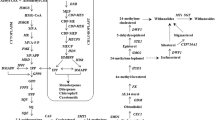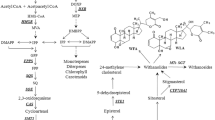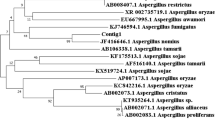Abstract
Indole-3-acetic acid (IAA) plays an important role in plant microbe interactions. Current study explored the role of indole-3-acetic acid (IAA) as a signalling molecule for chemical dialogue between endophytic fungus and host plant roots. The endophytic fungus was isolated from the leaves of drought stressed Withenia somnifera and was identified as Aspergillus awamori Wl1 through ITS region of 18 S rDNA sequence. The isolated Wl1 strain was capable of producing important secondary metabolites, including IAA, phenols and sugars. Culture filtrate of the strain contained 24.2, 275.4 and 127.4 μg/mL of IAA, phenols and sugars, respectively. The strain has efficiently colonized the maize roots and enhanced the growth of host plant. In order to determine the role of IAA in root colonization by endophyte, we inhibited the biosynthesis of IAA. Inhibition of IAA production by foliar application of yucasin effectively reduced the colonization of endophyte in maize roots by 52%, whereas root application of yucasin has decreased the colonization frequency by 66%. However, the application of IAA restored the ability of Aspergillus awamori to colonize maize roots and significantly improved various growth parameters. From these observations, it is concluded that IAA plays a vital role in initiating a crosstalk between the two partners.






Similar content being viewed by others
References
Ahmad F, Ahmad I, Khan MS (2005) Indole acetic acid production by the indigenous isolates of Azotobacter and fluorescent Pseudomonas in the presence and absence of tryptophan. Turkish J Biol 29:29–34
Arenal F, Platas G, Pelaez F (2007) A new endophytic species of Preussia (Sporormiaceae) inferred from morphological observations and molecular phylogenetic analysis. Fungal Divers 25:1–17
Badri DV, Quintana N, El Kassis EG, Kim HK, Choi YH, Sugiyama A, Verpoorte R, Martinoia E, Manter DK, Vivanco JM (2009) An ABC transporter mutation alters root exudation of phytochemicals that provoke an overhaul of natural soil microbiota. Plant Physiol 151:2006–2017
Barac T, Taghavi S, Borremans B, Provoost A, Oeyen L, Colpaert JV, Vangronsveld J, Van der Lelie D (2004) Engineered endophytic bacteria improve phytoremediation of water-soluble, volatile, organic pollutants. Nature biotechnol 22:583–588
Bashan Y, Holguin GAND, De-Bashan LE (2004) Azospirillum-plant relationships: physiological, molecular, agricultural, and environmental advances (1997-2003). Can J Microbiol 50:521–577
Chadha N, Prasad R, Varma A (2015) Plant promoting activities of fungal endophytes associated with tomato roots from central Himalaya, India and their interaction with Piriformospora indica. Int J Pharm Bio Sci 6:333–343
Chaparro JM, Sheflin AM, Manter DK, Vivanco JM (2012) Manipulating the soil microbiome to increase soil health and plant fertility. Biol Fertil Soils 48:489–499
Contreras-Cornejo HA, Macias-Rodriguez L, Cortes-Penagos C, Lopez-Bucio J (2009) Trichoderma virens, a plant beneficial fungus, enhances biomass production and promotes lateral root growth through an auxin-dependent mechanism in Arabidopsis. Plant Physiol 149:1579–1592
Costacurta A, Vanderleyden J (1995) Synthesis of phytohormones by plant-associated bacteria. Crit Rev Microbiol 21:1–18
Croteau R, Kutchan TM, Lewis NG (2000) Natural products (secondary metabolites). Biochem Mol biol plants 24:1250–1319
Dardanelli MS, Manyani H, Gonzalez-Barroso S, Rodriguez-Carvajal MA, Gil-Serrano AM, Espuny MR, Lopez-Baena FJ, Bellogín RA, Megías M, Ollero FJ (2010) Effect of the presence of the plant growth promoting rhizobacterium (PGPR) Chryseobacterium balustinum Aur9 and salt stress in the pattern of flavonoids exuded by soybean roots. Plant Soil 328:483–493
Dastogeer KM, LI H, Sivasithamparam K, Jones MG, DU X, Ren Y, Wylie SJ (2017) Metabolic responses of endophytic Nicotiana benthamiana plants experiencing water stress. Environ Exp Bot 143:59–71
El-Tarabily KA (2004) Suppression of Rhizoctonia solani diseases of sugar beet by antagonistic and plant growth-promoting yeasts. J Appl Microbiol 96:69–75
Fahad S, Bano A (2012) Effect of salicylic acid on physiological and biochemical characterization of maize grown in saline area. Pak J Bot 44:1433–1438
Fouda AH, Hassan SE-D, Eid AM, Ewais EE-D (2015) Biotechnological applications of fungal endophytes associated with medicinal plant Asclepias sinaica (Bioss.). Ann Agric Sci 60:95–104
Frankenberger WT, Poth M (1987) Biosynthesis of indole-3-acetic acid by the pine ectomycorrhizal fungus Pisolithus tinctorius. Appl Environ Microbiol 53:2908–2913
Fu S-F, Wei J-Y, Chen H-W, Liu Y-Y, Lu H-Y, Chou J-Y (2015) Indole-3-acetic acid: a widespread physiological code in interactions of fungi with other organisms. Plant Signal Behav 10:1048052
Gouda S, Das G, Sen SK, Shin HS, Patra JK (2016) Endophytes: a treasure house of bioactive compounds of medicinal importance. Front Microbiol 7:1538
Hamayun M, Khan SA, Iqbal I, Ahmad B, Lee I-J (2010) Isolation of a gibberellin-producing fungus (Penicillium sp. MH7) and growth promotion of crown daisy (Chrysanthemum coronarium). J Microbiol Biotechnol 20:202–207
Hassan SE, Hijri M, St-Arnaud M (2013) Effect of arbuscular mycorrhizal fungi on trace metal uptake by sunflower plants grown on cadmium contaminated soil. New Biotechnol 30:780–787
Hilbert, M., (2012). Biochemical and molecular analyses of the biosynthesis pathway of the indole derivatives in Piriformospora indica
Huang X-F, Chaparro JM, Reardon KF, Zhang R, Shen Q, Vivanco JM (2014) Rhizosphere interactions: root exudates, microbes, and microbial communities. Botany 92:267–275
Hussain A, Shah ST, Rahman H, Irshad M, Iqbal A (2015) Effect of IAA on in vitro growth and colonization of Nostoc in plant roots. Front Plant Sci 6:46
Hutsch BW, Augustin J, Merbach W (2002) Plant rhizodeposition—an important source for carbon turnover in soils. J Plant Nutr Soil Sci 165:397–407
Kaya C, Ashraf M, Dikilitas M, Tuna AL (2013) Alleviation of salt stress-induced adverse effects on maize plants by exogenous application of indoleacetic acid (IAA) and inorganic nutrients-a field trial. Aust J Crop Sci 7:249
Khalid A, Arshad M, Zahir ZA (2004) Screening plant growth-promoting rhizobacteria for improving growth and yield of wheat. J Appl Microbiol 96:473–480
Khan SA, Hamayun M, Yoon H, Kim H-Y, Suh S-J, Hwang S-K, Kim J-M, Lee I-J, Choo Y-S, Yoon U-H (2008) Plant growth promotion and Penicillium citrinum. BMC Microbiol 8:231
Khan R, Shahzad S, Choudhary MI, Khan SA, Ahmad A (2010) Communities of endophytic fungi in medicinal plant Withania somnifera. Pak J Bot 42:1281–1287
Khan N, Bano A, Babar MA (2016) The root growth of wheat plants, the water conservation and fertility status of sandy soils influenced by plant growth promoting rhizobacteria. Symbiosis, 72:(3), 195–205
Khan N, Bano A, Babar MA (2017) The root growth of wheat plants, the water conservation and fertility status of sandy soils influenced by plant growth promoting rhizobacteria. Symbiosis 72:195–205
Khan N, Bano A, Zandi P (2018) Effects of exogenously applied plant growth regulators in combination with PGPR on the physiology and root growth of chickpea (Cicer arietinum) and their role in drought tolerance. J Plant Interact 13:239–247
Khatoon S, Hanif NQ, Tahira I, Sultana N, Sultana K, Ayub N (2012) Natural occurrence of aflatoxins, zearalenone and trichothecenes in maize grown in Pakistan. Pak J Bot 44:231–236
Klamer M, Bååth E (2004) Estimation of conversion factors for fungal biomass determination in compost using ergosterol and PLFA 18: 2ω6, 9. Soil Biology and Biochemistry, 36:(1), 57–65
Lubna AS, Hamayun M, Gul H, Lee IJ, Hussain A (2018) Aspergillus niger CSR3 regulates plant endogenous hormones and secondary metabolites by producing gibberellins and indoleacetic acid. J Plant Interact 13:100–111
Ludwig-Muller J (2015) Bacteria and fungi controlling plant growth by manipulating auxin: balance between development and defense. J Plant Physiol 172:4–12
Mandal SM, Chakraborty D, Dey S (2010) Phenolic acids act as signaling molecules in plant-microbe symbioses. Plant Signal Behav 5:359–368
Martens DA (2002) Relationship between plant phenolic acids released during soil mineralization and aggregate stabilization. Soil Sci Soc Am J 66:1857–1867
Meletiadis J, Meis JF, Mouton JW, Verweij PE (2001) Analysis of growth characteristics of filamentous fungi in different nutrient media. J Clin Microbiol 39:478–484
Nishimura T, Hayashi KI, Suzuki H, Gyohda A, Takaoka C, Sakaguchi Y, Matsumoto S, Kasahara H, Sakai T, Kato JI (2014) Yucasin is a potent inhibitor of YUCCA, a key enzyme in auxin biosynthesis. Plant J 77:352–366
Pandey SS, Singh S, Pandey H, Srivastava M, Ray T, Soni S, Pandey A, Shanker K, Babu CV, Banerjee S, Gupta MM (2018) Endophytes of Withania somnifera modulate in planta content and the site of withanolide biosynthesis. Sci Rep 8:5450
Photita W, Lumyong S, Lumyong P, Hyde KD (2001) Endophytic fungi of wild banana (Musa acuminata) at doi Suthep Pui National Park. Thailand Mycol Res 105:1508–1513
Rafiq, C. M., Rafique, M., Hussain, A. & Altaf, M. (2010). Studies on heritability, correlation and path analysis in maize (Zea mays L.). J Agric Res 48:35–38
Rao RP, Hunter A, Kashpur O, Normanly J (2010) Aberrant synthesis of indole-3-acetic acid in Saccharomyces cerevisiae triggers morphogenic transition, a virulence trait of pathogenic fungi. Genetics 185:211–220
Reversat G, Boyer J, Sannier C, Pando-Bahuon A (1999) Use of a mixture of sand and water-absorbent synthetic polymer as substrate for the xenic culturing of plant-parasitic nematodes in the laboratory. Nematology 1:209–212
Rimmer DL, Abbott G (2011) Phenolic compounds in NaOH extracts of UK soils and their contribution to antioxidant capacity. Eur J Soil Sci 62:285–294
Rodriguez, R., White JR, J., Arnold, A. & Redman, A. R. A. 2009. Fungal endophytes: diversity and functional roles. New Phytol 182, 314–330
Schubert S, Neubert A, Schierholt A, Sümer A, Zörb C (2009) Development of salt-resistant maize hybrids: the combination of physiological strategies using conventional breeding methods. Plant Sci 177:196–202
Schulz B, Boyle C (2005) The endophytic continuum. Mycol Res 109(6):661–686
Shahab S, Ahmed N, Khan NS (2009) Indole acetic acid production and enhanced plant growth promotion by indigenous PSBs. Afr J Agri Res 4:1312–1316
Sieber TN, Waisel Y, EsheL A, Kafkafi U (2002) Fungal root endophytes. Plant roots: the hidden half:887–917
Spaepen S, Vanderleyden J, Remans R (2007) Indole-3-acetic acid in microbial and microorganism-plant signaling. FEMS Microbiol Rev 31:425–448
Strobel G A (2003) Endophytes as sources of bioactive products. Microbes and infection 5:(6), 535–544.
Suryanarayanan TS, Venkatesan G, Murali TS (2003) Endophytic fungal communities in leaves of tropical forest trees: diversity and distribution patterns. Curr Sci:489–493
Suryanarayanan TS, Thirunavukkarasu N, Govindarajulu MB, Sasse F, Jansen R, Murali TS (2009) Fungal endophytes and bioprospecting. Fungal biology reviews 23:(1–2), 9–19
Taiz, L. and Zeiger, E., (1998). Auxins. Plant Physiology. Sunderland, MA: Sinayer Associates 543–589
Vandeleur RK, Sullivan W, Athman A, Jordans C, Gilliham M, Kaiser BN, Tyerman SD (2014) Rapid shoot-to-root signalling regulates root hydraulic conductance via aquaporins. Plant Cell Environ 37:520–538
Vila-aiub MM, Martinez-Ghersa MA, Ghersa CM (2003) Evolution of herbicide resistance in weeds: vertically transmitted fungal endophytes as genetic entities. Evol Ecol 17:441–456
Waqas M, Khan AL, Kamran M, Hamayun M, Kang S-M, Kim Y-H, Lee I-J (2012) Endophytic fungi produce gibberellins and indoleacetic acid and promotes host-plant growth during stress. Molecules 17:10754–10773
Waqas M, Khan AL, Kang SM, Kim YH, Lee IJ (2014) Phytohormone-producing fungal endophytes and hardwood-derived biochar interact to ameliorate heavy metal stress in soybeans. Biol Fert Soils 50:1155–1167
Weert S, Vermeiren H, Mulders IH, Kuiper I, Hendrickx N, Bloemberg GV, Vanderleyden J, De Mot R, Lugtenberg BJ (2002) Flagella-driven chemotaxis towards exudate components is an important trait for tomato root colonization by Pseudomonas fluorescens. MPMI 15:1173–1180
Yuan ZC, Haudecoeur E, Faure D, Kerr KF, Nester EW (2008) Comparative transcriptome analysis of agrobacterium tumefaciens in response to plant signal salicylic acid, indole-3-acetic acid and γ-amino butyric acid reveals signalling cross-talk and agrobacterium–plant co-evolution. Cell Microbiol 10:2339–2354
Yue Q, Miller CJ, White JF, Richardson MD (2000) Isolation and characterization of fungal inhibitors from Epichlo ë festucae. J Agric Food Chem 48:4687–4692
Zahoor M, Irshad M, Rahman H, Qasim M, Afridi SG, Qadir M, Hussain A (2017) Alleviation of heavy metal toxicity and phytostimulation of Brassica campestris L. by endophytic Mucor sp. MHR-7. Ecotoxicol Environ Safety 142:139–149
Zhang HW, Song YC, Tan RX (2006) Biology and chemistry of endophytes. Nat Prod Rep 23:753–771
Zhao Y (2010) Auxin biosynthesis and its role in plant development. Annual review of plant biology 61:49–64
Author information
Authors and Affiliations
Corresponding author
Ethics declarations
Conflict of interest
The authors have no conflict of interest. The work presented is according to current law of the country where carried out.
Rights and permissions
About this article
Cite this article
Mehmood, A., Hussain, A., Irshad, M. et al. In vitro production of IAA by endophytic fungus Aspergillus awamori and its growth promoting activities in Zea mays. Symbiosis 77, 225–235 (2019). https://doi.org/10.1007/s13199-018-0583-y
Received:
Accepted:
Published:
Issue Date:
DOI: https://doi.org/10.1007/s13199-018-0583-y




